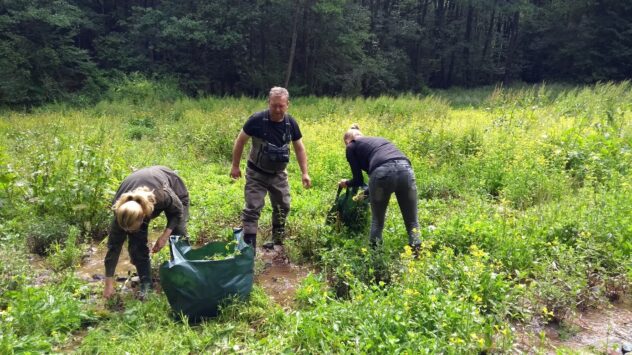
W toku prac terenowych związanych z reintrodukacją rdestniczki gęstej (Groenlandia densa) During the field work related to the reintroduction of Groenlandia densa carried out in 2018-2019, the LIFEDrawaPL project team drew attention to the presence of an invasive species, i.e. Mimulus guttatus ascending in the upper sections of the watercourses or directly in the water-heads zone.
Two such objects in the project’s area – the water-heads of the Błotnica River and the Zielenica River were thus excluded from the reintroduction procedures because Mimulus guttatus almost completely covered the places of groundwater outflow there, the shallow watercourse channel and the coastal zone. This species transformed the natural rush and herbaceous vegetation that functioned as a buffer and gradually displaced species related to the water-heads zone, including Berula ercecta, Veronica becabunga, V.anagallis-aquatica or Nasturtium officinale, i.e. taxa characteristic for the poor or initial form of the habitat of water-crowfoots rivers which develop in the headwaters of rivers and streams, close to their sources. The invasive species, which is Mimulus guttatus, led not only to the deterioration of the habitat, but also to its degradation by eliminating the characteristic species identifying this habitat (according to the methodology of the Chief Inspectorate of Environmental Protection – assessment of the condition of the habitat U2).
The change of the habitat conditions in the water-heads zone, below which the reintroduction sites of Greonlandia densa are located, poses a threat to the future because the watercourse is a migration corridor of invasive species diasporas. Besides, considering the watercourse from its source to the estuary as one ecosystem, at the very beginning there was a drastic change in the habitat conditions, including the reconstruction of the species composition of the vegetation affecting the water chemistry, increasing evapotranspiration as Mimulus guttatus grows quickly, is a moisture-loving plant and evaporates. (transpires) very large amounts of water, changing the water relations in the spring itself. The only and effective method of active protection of a habitat controlled by an invasive species is its mechanical elimination, while maintaining accuracy in removing spore organs that favour vegetative reproduction (underground runners, fragments of easily rooted shoots), and thus limiting its expansion.
In 2019 Mimulus guttatus massively spread in the Biela River valley, directly threatening Groenlandia densa, overgrowing its reintroduction sites in the shallow sand-gravel bottom of the watercourse. The shoots of Mimulus guttatus, by transpirating huge amounts of water from the ground, lowered its level in the watercourse starting from the water-heads area in the upper part of the valley.
Therefore, in 2019 as part of the LIFEDrawaPL project, activities aimed at the elimination of the species were initiated by conducting an inventory of the places where Mimulus guttatus occurs. The inventory results are available in Downloads section.
In 2020, when the fight against the foreign species began, a very fast spread and densification of Mimulus guttatus coverage on individual areas inventoried in 2019 was found – even by 100%.

In order to secure the sites of Greonlandia densa , which found exceptionally favourable conditions in this area, the Team performed 5 field trips to remove the invasive species with the participation of RDEP’s employees. The team was supported in the organization of work by representatives of the Polanów Forest District.
The project’s team, with the great support of RDEP’s employees in Szczecin and the Directorate itself, carried out Mimulus guttatus removal action on 09.07; 15.07; 23.07. 30.07. and 03.08.2020.
Initially, Mimulus guttatus was mowed and then torn out by hand, trying to reveal the gravel-rocky ground and allow water to seep from the water-heads. The biomass was carried out in bags and packed on a trailer. On average, after each working day of groups of 6-8 people, 4-6 tons of the biomass were transported for disposal.
The sites of Greonlandia densa in the Biegała valley, where the removal of the invasive species was carried out, were marked against an accidental destruction



















From 12th August 2020 further elimination works are already carried out by an external entity.







During the site vision at the end of September 2020 no more specimens of blooming Mimulus guttatus were found. A significant increase in the supply of groundwater to the watercourses, previously intercepted by Mimulus guttatus biomass, was observed. On the surfaces where the treatment was performed, single specimens still appeared, loosely lying on the sward growing on peat domes. On rocky water-heads or places where water flows from underground courses, from leftover fragments of shoots, they rooted and gradually renewed rosettes of young leaves. In well-lit places, with shallow water, you could still see single sprouting Mimulus guttatus specimens. The dynamics of the renewal of the invasive species population has been clearly slowed down and positive effects of the work have been observed and the work will be continued until the end of October 2020.